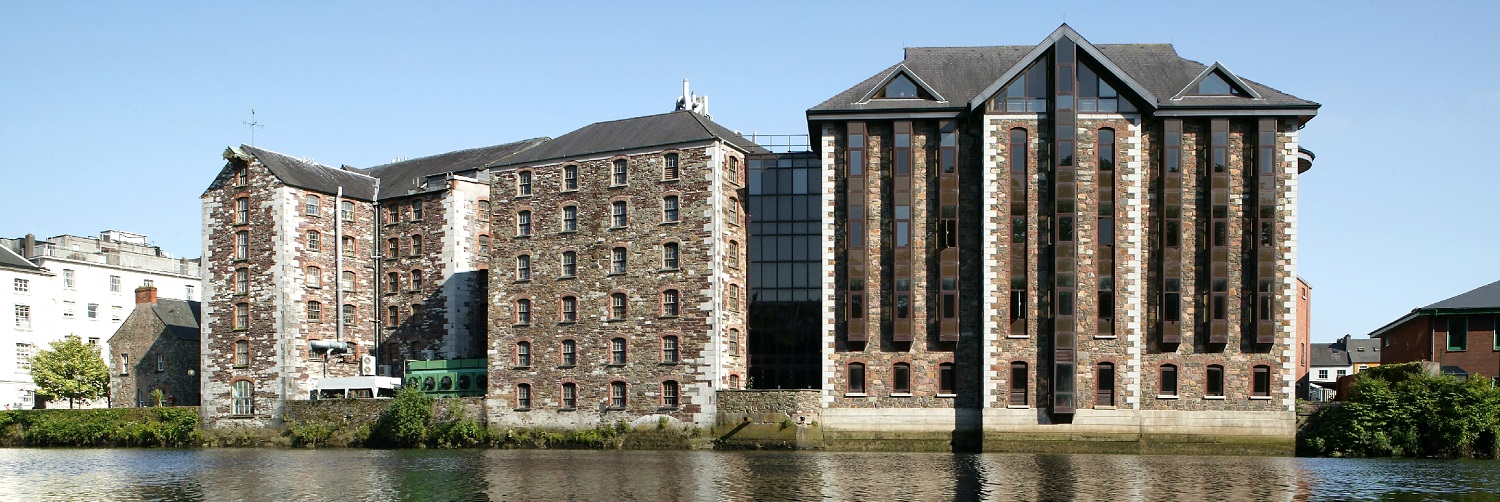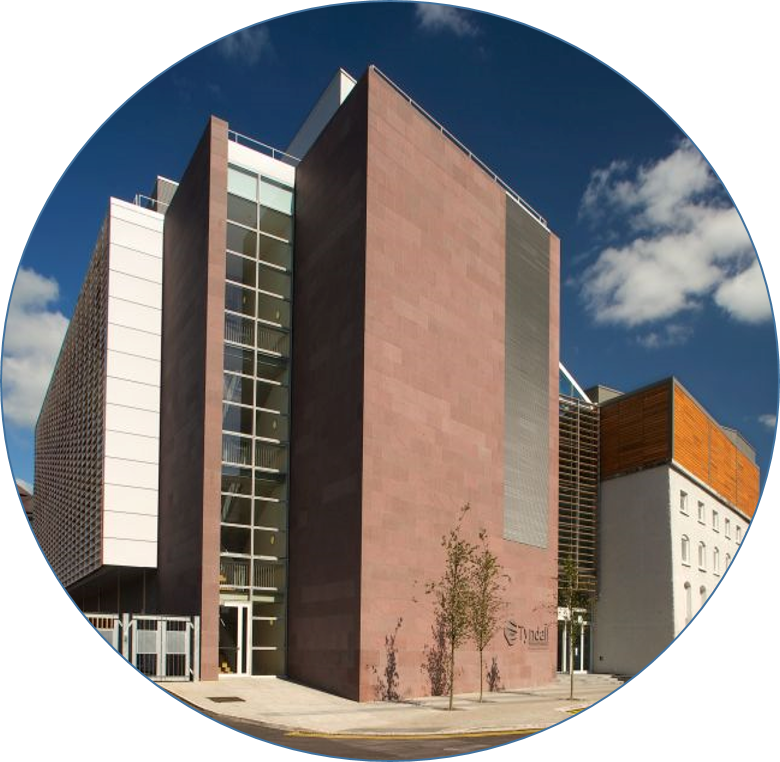
The complex of buildings known as the Lee Maltings, now the home of the Tyndall National Institute, forms one of the most significant surviving industrial sites in Cork city dating back to the eighteenth century. It incorporates the original site of a flour mills, a brewery, a malting operation and related storage, residential and other facilities.
The first development of the site commenced after 1787 when Atwell Hayes was granted a lease of a field adjoining Red House Walk, for twenty years at an annual rent of £25 plus thirty good salmon (or 2/4d in lieu of each salmon). On the eastern side of this field Hayes built a Bolting Mill with extensive stores. This became known as Hayes’ Mills, later Lee Mills (and by the late eighteenth century had become known as the Lee Tide Watermills), and operated with three wooden undershot wheels, the largest of which was only 7ft in diameter. The mill comprised two extensive mills and kilns, a corn store and a miller’s house that consisted of a sitting room, bedrooms and a kitchen. This building still survives today.
The Lee Mills was the largest water-powered flour and corn milling installation to become established on the north channel of the River Lee, and was also the last flour mills within the city to rely solely on water for milling.
In 1797 Hayes granted a lease to the western part of the lands to Joseph Reeves, on which the River Lee Porter Brewery was erected, and which operated until 1813. Brewing and distilling have been long important in Cork with the main ingredients of water and barley being in plentiful supply. In the mid eighteenth century Cork boasted of fifteen breweries within the city, all located by the river to facilitate ease of access for transport and for the important water supply:
Most of these breweries concentrated on the production of porter which was a type of beer that became popular from the eighteenth century. This dark coloured beer was favoured by the market porters in London, hence its name, and could be made in bulk and improved when left to mature. Commercial breweries improved the quality of porter being produced in Cork from the early nineteenth century and it became very popular. Later that century, breweries began to produce stout, a stronger beer, which soon achieved an important place in the market.
Beamish & Crawford (B&C), formerly Cork Porter Brewery (which was established in 1792), purchased the River Lee Porter Brewery in 1813 and also became tenants of the mills around that time.
From 1815 to 1820 the Lee Mills ground only for toll, and it was not until 1825 that B&C began the process of acquiring a long-term interest in the mills. The greater part of the existing six and seven storey buildings were entirely rebuilt on the site of the original mills by B&C before 1831. Alterations to the mills continued throughout the mid-nineteenth century and by 1881 the mills, now known as The Lee Tide Watermills, comprised two mills with an annual output of approximately 40,000 barrels and combined storage of 16,000 barrels. By this time it also now contained Lee Mills House, as a gatekeepers house and providing dormitories for the maltmen.
Lee Mills House has recently undergone a substantial refurbishment, maintaining its original character, and is in use today as a high quality office building.
It is also interesting to note that George Boole, then Professor of Mathematics at the newly opened Queen’s College Cork and his wife Mary Everest Boole, also a mathematician, moved nearby to 5 Grenville Place in 1849. It was here George Boole invented Boolean Algebra which is the basis for the design of circuits used in computers.
By the late 1880’s B&C began to concentrate their malting operations between the Lee Maltings and Morrison’s Island (in the city centre), converting the mills to a malting facility (malting barley being a vital brewing ingredient). The millrace was in-filled during in 1903 and kilns, a dropping room and malt floors and stores installed. Cartographic evidence suggest that the Lee Maltings complex remained relatively unchanged from this time possibly until the late 1950’s, with the only additional building activity in the area over the mill-race channel to the north-west of the site.
 The Lee Maltings was purchased by UCC from B&C in 1968 and work commenced on converting the existing buildings for university laboratory and teaching use, as well as the provision of an indoor sports facility and the original location of the UCC Granary Theatre. Initially, and up to the 1990’s, the complex was home to a large and varied number of academic departments.
The Lee Maltings was purchased by UCC from B&C in 1968 and work commenced on converting the existing buildings for university laboratory and teaching use, as well as the provision of an indoor sports facility and the original location of the UCC Granary Theatre. Initially, and up to the 1990’s, the complex was home to a large and varied number of academic departments.
As part of an incentive package to attract the semiconductor manufacturing industry to Ireland in 1979, the Government agreed to provide a silicon wafer-fabrication laboratory providing R&D and specialised training facilities for such organisations expected to locate in Ireland.
On this basis it was decided to establish the National Microelectronics Research Centre (NMRC) in 1981 in Cork and the Lee Maltings became the home of the fledgling NMRC.
In 1982 the small team led by Prof. Gerry Wrixon took occupancy of the Maltings building referred to as ‘Phase 1’, one of the buildings now part of the current Block A.
Over the next 20 years NMRC grew to become the largest research centre in Ireland and developed a strong reputation for research excellence within Ireland and Europe. However, as growth became restricted due to the constraints of the infrastructure at the time, proposals were made to the Department of Enterprise, Trade & Innovation (DETI) for funding for expanded facilities.
In 2002 an international panel of experts carried out a review of NMRC at the request of DETI. The panel strongly recommended the construction of a new facility to build on the strengths of the NMRC to better serve Irish industry and academia.
The Tyndall National Institute was subsequently established in 2004, under a formal agreement between the Minister for Enterprise, Trade & Innovation and UCC. As part of this agreement, a significant investment in Tyndall of €50m was made by the Irish government, which enabled the construction of the new research building and the substantial upgrading of the support facilities and the existing buildings infrastructure.
Tyndall now hosts over 450 research scientists, engineers, industry personnel, students and support staff creating a critical mass of researchers with extensive state-of-the-art research facilities. The Institute undertakes ground-breaking research in the areas of Micro/Nanoelectronics, Microsystems, Photonics and Modelling, Theory & Design for applications in Communications, Healthcare, Energy and the Environment.
Tyndall now occupies the entire Lee Maltings site, a world class state-of-the-art research facility.
From Porter to Photonics!